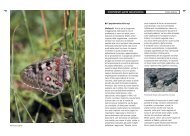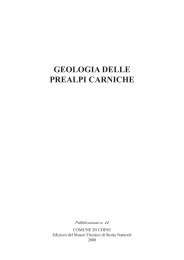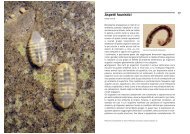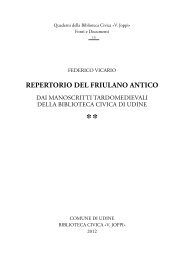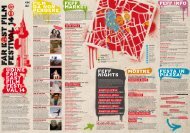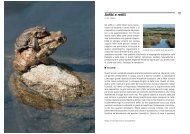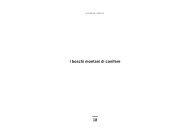Despite its inhospitable appearance and lack of any ... - Udine Cultura
Despite its inhospitable appearance and lack of any ... - Udine Cultura
Despite its inhospitable appearance and lack of any ... - Udine Cultura
Create successful ePaper yourself
Turn your PDF publications into a flip-book with our unique Google optimized e-Paper software.
60<br />
those associated with percolating water in caves. They are stenothermal<br />
animals, sometimes living in cold waters, as they have recently been found<br />
at high altitudes in the Alps.<br />
■ Thermosbaenaceans<br />
Thermosbenaceans, like bathynellaceans,<br />
are an order <strong>of</strong> very ancient<br />
malacostracans, with about 30<br />
stygobiont species living in fresh <strong>and</strong><br />
slightly brackish water from the<br />
Caribbean sector to the circum-<br />
Mediterranean area, eastern Africa,<br />
Monodella stygicola (ca. 15x)<br />
Asia, <strong>and</strong> Australia. This group clearly<br />
differs from other malacostracans, due<br />
to the dorsal egg pouch formed by the carapace.<br />
The evolution <strong>of</strong> thermosbaenaceans is probably associated with the retreat <strong>of</strong><br />
the sea following uplift caused by plate tectonics. The species <strong>of</strong>ten live in<br />
isolated locations <strong>and</strong> are <strong>of</strong> great biogeographical interest. Their name is<br />
misleading, as it refers to thermal water: in fact, it derives from the first species<br />
described, which was collected in an African thermal spring.<br />
Italy hosts four species - three <strong>of</strong> which are endemic to the country - living in<br />
saturated aquifers. Limnosbaena finki is found in karstic <strong>and</strong> alluvial water in<br />
north-eastern Italy (it is distributed as far as Bosnia); Monodella stygicola only<br />
lives in karstic habitats, occasionally in alluvial aquifers, in Apulia; Tethysbaena<br />
argentarii is an endemic species <strong>of</strong> anchialine waters in the Grotta di Punta<br />
degli Stretti (Argentario Promontory, Tyrrhenian), <strong>and</strong> Tethysbaena siracusae is<br />
endemic to the karstic area <strong>of</strong> Porto Palo in south-eastern Sicily.<br />
Spelaeomysis bottazzii (ca. 1x)<br />
■ Mysidaceans<br />
Mysidaceans, or opossum shrimps, are<br />
malacostracans generally living in sea<br />
or brackish water. In Italy, there are two<br />
stygobiont genera, Stygiomysis <strong>and</strong><br />
Spelaeomysis, in anchialine <strong>and</strong><br />
freshwater in karstic areas in Apulia.<br />
The Mediterranean area hosts a third<br />
stygobiont species, Troglomysis, in the<br />
Dinaric karst. These detrivorous <strong>and</strong> saprophagous animals are 2-3 cm long -<br />
thus, unusually large compared with other mysids - <strong>and</strong> are found in small<br />
lakes, seldom in flowing water.<br />
A euryhaline <strong>and</strong> eurythermal species, Spelaeomysis bottazzii, usually lives in<br />
anchialine habitats in south-eastern Italy, between the Gargano <strong>and</strong> Salento<br />
(Apulia), even in polluted water. Stygiomysis hydruntina is rare, <strong>and</strong><br />
presumably lives further down, where the water-table recharges; so far, it has<br />
only been collected on the Ionian side <strong>of</strong> the province <strong>of</strong> Lecce. The two<br />
species may locally cohabit. Although electrophoretic analyses suggest that<br />
the species are <strong>of</strong> recent, perhaps Pliocene origin, similar species in Mexico,<br />
the Caribbean <strong>and</strong> eastern Africa imply a more ancient, Tethyan origin.<br />
■ Isopods<br />
Woodlice are a very diversified order<br />
<strong>of</strong> malacostracan crustaceans, with<br />
more than 10,000 known species.<br />
They presumably colonised Italian<br />
groundwater from marine (cirolanids,<br />
microparasellids, microcerberids)<br />
<strong>and</strong> surface freshwater ancestors<br />
(asellotans <strong>and</strong> perhaps sphaeromatids).<br />
Each family is a microcosm in <strong>its</strong>elf,<br />
Proasellus franciscoloi (ca. 6x)<br />
<strong>and</strong> their study reveals very interesting<br />
biogeographical aspects.<br />
Asellids. Almost all stygobiont species <strong>of</strong> this family are Italian endemics.<br />
Asellus cavernicolus lives in the river Timavo (Trieste Karst). Results from<br />
molecular studies reveal that it is a relict species deriving from pre-glacial<br />
colonisation <strong>of</strong> the Trieste Karst by an epigean species, Asellus aquaticus. In<br />
Italy, the genus Proasellus counts several surface as well as cavernicolous<br />
<strong>and</strong> interstitial species.<br />
The genus diversified into m<strong>any</strong> phyletic lines, the taxonomy <strong>of</strong> which<br />
requires clarification: the group deminutus in north-eastern Italy; pavani in the<br />
central-eastern Pre-Alps; cavaticus in France, western Piedmont <strong>and</strong> Liguria,<br />
in karstic environments (P. cavaticus, P. franciscoloi), <strong>and</strong> the group patrizii,<br />
exclusive to Sardinian groundwater. In addition, there are m<strong>any</strong> similar<br />
species: P. ligusticus, found from Liguria to the Apuan Alps, <strong>and</strong> P. acutianus,<br />
in Tusc<strong>any</strong>, Latium <strong>and</strong> the isl<strong>and</strong> <strong>of</strong> Elba are the most widely distributed<br />
61




